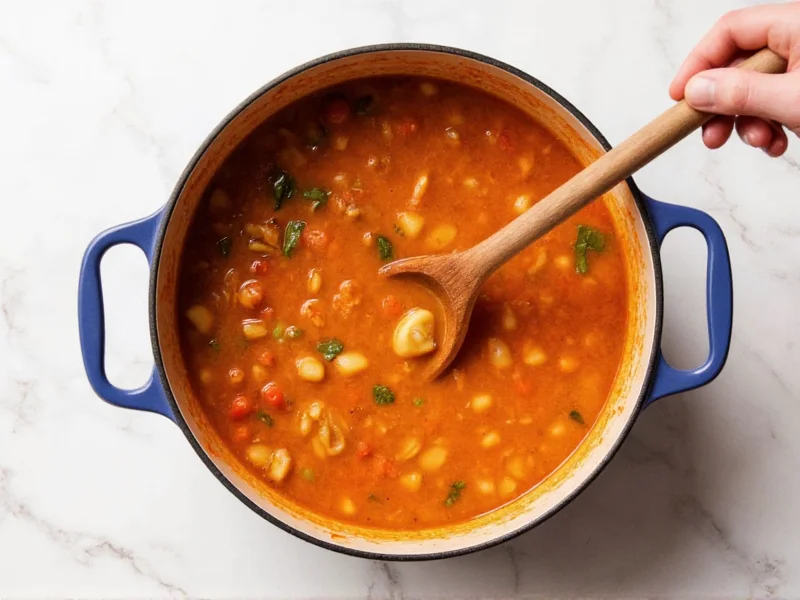Minestrone soup is an authentic Italian vegetable soup that's simple to prepare with fresh ingredients, requiring just 20 minutes of prep time and 45 minutes of cooking. This hearty, vegetarian-friendly dish combines seasonal vegetables, beans, pasta, and a rich tomato broth for a nutritious meal that serves 6-8 people.
Creating authentic minestrone soup doesn't require culinary expertise—just quality ingredients and proper technique. This traditional Italian peasant soup has evolved over centuries but maintains its core identity as a flexible, vegetable-packed meal that uses whatever produce is in season. The beauty of minestrone lies in its adaptability while preserving authentic flavor profiles that have made it a global favorite.
Essential Ingredients for Perfect Minestrone Soup
While regional variations exist across Italy, certain ingredients form the foundation of a genuine minestrone. The soffritto (Italian flavor base) is non-negotiable for authentic taste. Below is the complete ingredient list with precise measurements:
| Category | Ingredients | Measurement |
|---|---|---|
| Flavor Base | Extra virgin olive oil | 3 tablespoons |
| Flavor Base | Yellow onion, finely diced | 1 medium |
| Flavor Base | Carrots, finely diced | 2 medium |
| Flavor Base | Celery stalks, finely diced | 2 stalks |
| Tomato Component | Canned crushed tomatoes | 28 ounces |
| Vegetables | Zucchini, diced | 1 medium |
| Vegetables | Green beans, trimmed and cut | 1 cup |
| Beans | Cannellini beans, drained | 15 ounces |
| Pasta | Small pasta (ditalini or elbow) | ¾ cup |
| Liquid | Vegetable broth | 6 cups |
| Seasoning | Fresh basil, chopped | ¼ cup |
| Seasoning | Dried oregano | 1 teaspoon |
| Finishing | Freshly grated Parmesan | To serve |
Step-by-Step Preparation Guide
Follow these professional techniques to create restaurant-quality minestrone soup at home. The key to authentic flavor development lies in proper layering of ingredients and cooking sequence.
Building the Flavor Foundation
Heat olive oil in a large Dutch oven over medium heat. Add the diced onion, carrots, and celery—the holy trinity of Italian cooking known as soffritto. Sauté for 8-10 minutes until vegetables soften but don't brown. This gentle cooking releases natural sugars without caramelization, creating a clean flavor base essential for traditional minestrone soup preparation.
Developing the Broth
Add the crushed tomatoes with their juice to the pot. Stir well and cook for 5 minutes to allow the tomato acids to mellow. Pour in the vegetable broth, increase heat to medium-high, and bring to a gentle boil. This tomato-broth combination creates the signature rich yet balanced base that distinguishes authentic minestrone from other vegetable soups.
Adding Vegetables and Beans
Reduce heat to medium and add zucchini, green beans, and dried oregano. Simmer uncovered for 15 minutes until vegetables begin to soften. Stir in the cannellini beans and continue simmering for another 5 minutes. Adding vegetables in stages ensures each maintains its ideal texture—crucial for that perfect minestrone soup consistency where no ingredient overcooks.
Incorporating Pasta and Finishing Touches
Add the small pasta and simmer for 8-10 minutes until al dente. Remove from heat and stir in fresh basil. For the most authentic minestrone soup experience, let the soup rest for 15 minutes before serving—this allows flavors to meld beautifully. Season with salt and freshly ground black pepper to taste.
Pro Tips for Exceptional Minestrone
Mastering how to make traditional minestrone soup from scratch requires attention to these professional details:
- Pasta timing matters: Cook pasta separately and add just before serving if you plan to store leftovers—this prevents mushy texture in reheated soup
- Seasoning progression: Add salt in stages rather than all at once for balanced flavor development
- Acidity balance: A splash of red wine vinegar (1-2 teaspoons) just before serving brightens flavors
- Texture variation: Reserve some diced vegetables to add in the last 5 minutes for contrasting texture
- Umami boost: Add a Parmesan rind while simmering for deeper flavor (remove before serving)
Variations and Dietary Adaptations
While authentic minestrone soup follows specific regional traditions, modern adaptations accommodate various dietary needs without sacrificing flavor:
- Gluten-free version: Substitute gluten-free small pasta or add extra diced potatoes
- Vegan option: Omit Parmesan or use nutritional yeast for cheesy flavor
- Protein boost: Add ½ cup cooked lentils or chickpeas for additional plant-based protein
- Seasonal variations: In spring, use asparagus and peas; in fall, incorporate butternut squash and kale
- Meat addition: For non-vegetarian version, add 4 ounces diced pancetta with the soffritto
Storage and Reheating Instructions
Minestrone soup actually improves in flavor after 24 hours as ingredients meld. Follow these storage guidelines for best results:
- Cool completely before storing—never put hot soup directly in the refrigerator
- Store in airtight containers for up to 5 days in the refrigerator
- Freeze without pasta for up to 3 months (add fresh pasta when reheating)
- Reheat gently over medium-low heat, adding splashes of broth or water if needed
- Revitalize flavors with fresh herbs and a drizzle of quality olive oil after reheating
Troubleshooting Common Minestrone Issues
Even experienced cooks encounter challenges when preparing how to make minestrone soup. Here's how to fix common problems:
- Soup too thin: Simmer uncovered for 10-15 minutes to reduce, or create a slurry with 1 tablespoon cornstarch and 2 tablespoons cold water
- Soup too thick: Gradually add additional broth or water until desired consistency
- Bland flavor: Add acidity with lemon juice or vinegar, or deepen flavors with additional soffritto sautéed separately
- Overcooked vegetables: Add fresh vegetables in the last 5-10 minutes of cooking next time
- Salty broth: Add a peeled potato to absorb excess salt, or dilute with unsalted broth











 浙公网安备
33010002000092号
浙公网安备
33010002000092号 浙B2-20120091-4
浙B2-20120091-4